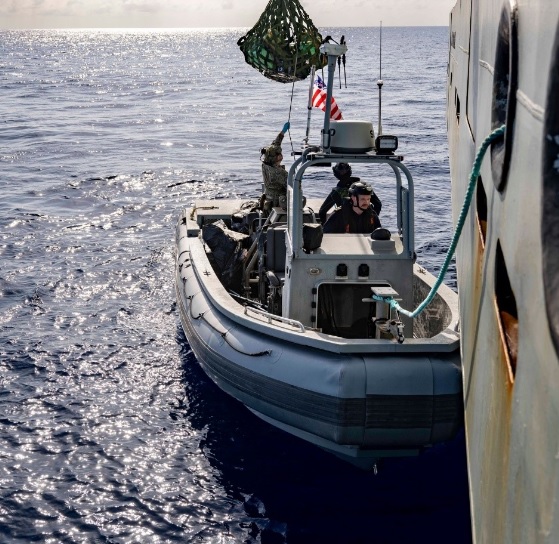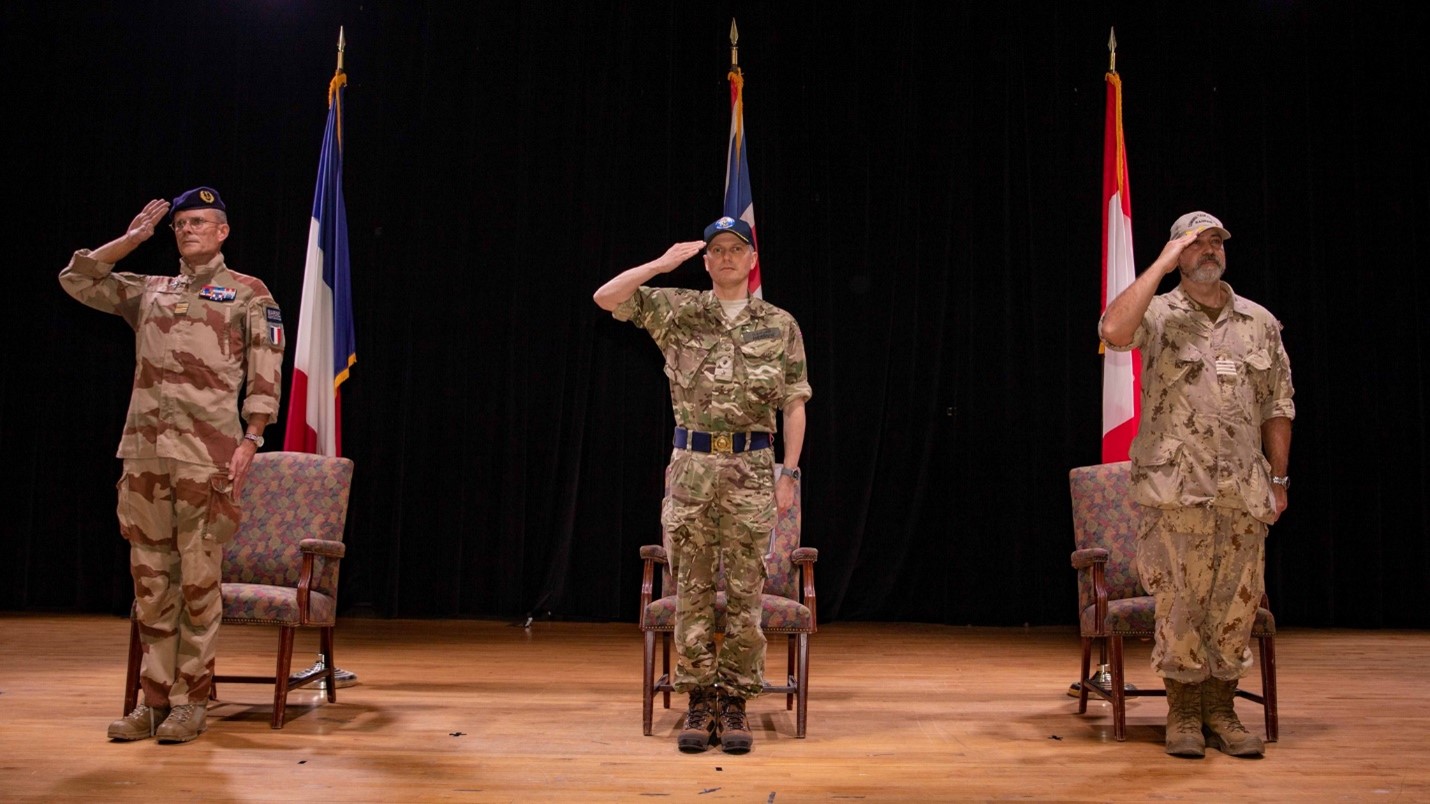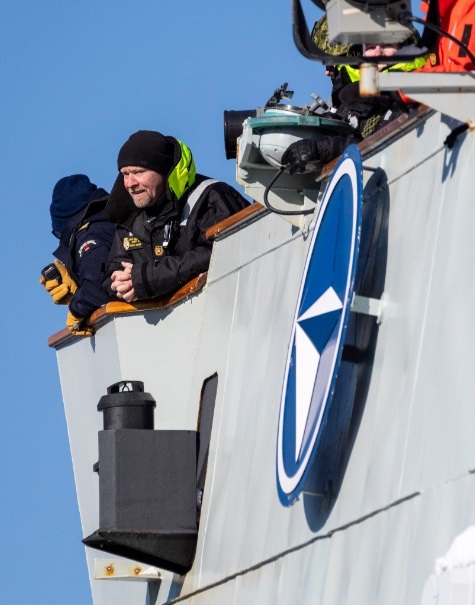Our Navy Today - Volume 6 Issue 8

Volume 7 | Issue 1
Operations update
HMCS Margaret Brooke intercepts smuggling vessel on Op Caribbe

Caption
The United States Coast Guard Law Enforcement Detachment returns to HMCS Margaret Brooke.
On February 4, while deployed on Operation Caribbe, His Majesty’s Canadian Ship (HMCS) Margaret Brooke supported the interception of a drug smuggling vessel and seized 510 kg of cocaine in the Central Caribbean Sea.
The three people suspected of drug smuggling are now in custody of the United States government on suspicion of drug trafficking, and the vessel was disposed of at sea as it posed a threat to navigation.
Margaret Brooke departed its home port of Halifax, N.S. on January 12 to deploy for six weeks on Operation Caribbe in the Caribbean Sea and the Atlantic Ocean.
“I am proud of the crew of HMCS Margaret Brooke and the members of the embarked United States Coast Guard Law Enforcement Detachment who have successfully interdicted a drug smuggling vessel,” said Commander Nicole Robichaud, Commanding Officer. “The sailors of HMCS Margaret Brooke have worked determinedly since Operation Caribbe commenced last month, between operational training and working closely with our United States partners. This collective effort enables us to achieve greater success in making the continent more secure from the threats posed by illicit trafficking.”
Canada takes Command of Combined Task Force 150

Caption
Captain (Navy) Collin Matthews (right) assumes command of Combined Task Force 150 (CTF 150) from French Navy Captain Yannick Bossu.
On January 17 Canada assumed command of Combined Task Force 150 (CTF 150) from France at a ceremony held in Bahrain. Captain (Navy) (Capt(N)) Collin Matthews has assumed command of the multinational coalition tasked with conducting maritime security operations and capacity building in the Gulf of Oman and North Arabian Sea, until July 2024.
CTF 150 is one of five Combined Task Forces, each with its own area of operations or focus, operated by Combined Maritime Forces, which was created in 2001 to uphold the Rules Based International Order by countering illicit actors on the high seas and promoting security and stability across the Middle East and the Horn of Africa.
“The success of this operation lies with our ability to work with like-minded nations toward the same goals, ensuring that legitimate commercial shipping can transit the region free from non-state threats and we are ready to face this task,” said Capt(N) Matthews.
HMCS Charlottetown joins Ex Steadfast Defender 24

Caption
HMCS Charlottetown departed its home port of Halifax on January 31.
HMCS Charlottetown departed on January 31 to participate in Exercise Steadfast Defender until March 31.
Approximately 1,000 sailors, soldiers, and aviators from across Canada will participate in both sea and land components of the exercise, making it the largest NATO exercise in decades.
Charlottetown, with an embarked Royal Canadian Air Force CH-148 Cyclone helicopter will participate with the enhanced Forward Presence Battle Group Latvia, and elements of the Canadian Special Operations Forces Command.
The RCN’s participation in this large multi-national exercise increases Canada’s long-term security. When we work together with partners we better ensure our common ability to respond to threats to our way of life.
Operations Forecast
The RCN will take command of Standing NATO Maritime Group 2 this summer.
In June, HMCS Vancouver will leave Esquimalt for Exercise RIMPAC, before deploying to the Indo-Pacific for Ops Horizon and Neon. In the fall HMCS Ottawa will join Vancouver on Op Horizon to boost our military presence in the Indo-Pacific. With an extra warship in the region we will participate in more international exercises enhancing security cooperation with regional partners. Op Horizon generates opportunities to collaborate with allies, allowing us to play a more active role in regional security.
2024 on the horizon
Colleagues and shipmates, today our Navy is operating in an incredible moment in history. This is an era of immense potential for our sailors as we navigate the largest revitalization of our fleet, recruitment methods, and associated training systems since the Second World War while implementing a fundamental change to our culture. We are undertaking this work to remain a Navy that reflects Canadian values, and to be capable of defending the nation we have pledged to protect.
At the same time, we are attempting to mitigate serious challenges that could cause us to fail to meet our force posture and readiness in 2024 and beyond.
Here is a brief overview of what 2024 has on the horizon for us, both in terms of challenges and initiatives, through the lens of our three main priorities: People, Platforms and Ready to Fight.
People
We all know we are facing shortages in our personnel, limiting our ability to maintain and crew our newest ships, which will further stress our sailors as our new platforms are delivered and put to sea this year and in the years to come.
For those of you who have taken on additional work so the RCN can meet its commitments, thank you. Through your sacrifice and efforts, you are keeping our fleet a fighting force. History has told us that the best sailors, not the best ships, win at sea.
With the requirements of the future fleet on the immediate horizon, RCN leadership recognize that today’s occupation structures will not meet tomorrow’s requirements. Instead of addressing each occupation in silos RCN leadership made a deliberate decision to conduct this occupational analysis holistically. A new team called the Future Occupation Structures Development Team was stood up to define both pan-RCN problem sets as well as the problem definition for each in-scope RCN managed occupation. Using this framework, RCN members posted in Chief Military Personnel will begin the occupational analysis this summer.
The team is taking care to balance the identity of trades with an approach to consolidating areas of capability, defining a logical and predictable career progression, and meeting the needs of the RCN. Updates will be shared as the team makes progress.
Regarding the Marine Technician (MAR TECH) occupation, the Naval General Order (NAVGEN) released in June of last year acknowledged the mistakes made when changing to an operator/generalist approach without conducting proper analysis and engagement with MAR TECHs. Working with the MAR TECH community we are trying to correct course by moving towards a maintainer/operator approach. The new occupation structure is informed by two years of research, analysis, and engagement with MAR TECHs.
We can all expect to experience more change as we imagine solutions to accomplish our goals.
Sometimes stress creates space for the most creative solutions, like the Naval Experience Program (NEP). The program has shown promise in bringing new sailors to help offset current shortages and is putting the Navy front of mind for those joining the Canadian Armed Forces.
Or the Marine Career Expo (MCE), which gives the Canadian public a unique opportunity to engage with our sailors.
Both the NEP and MCE are programs designed to help the RCN recruit our target of 1,200 new sailors.
Platforms
We have a lot to look forward to this year as we will see the many years of work we have all done come to fruition as we receive new ships that will provide an incredible opportunity for tomorrow’s sailors.
2024 will see many milestones with our newest platforms demonstrating their indispensable role in Canada's Arctic and global maritime operations. Several new ships will be delivered while the Canadian Surface Combatant (CSC) project makes progress in its design, forecasting the Critical Design Review for the end of this year.
HMCS Frédéric Rolette is scheduled for sea acceptance trials in July. This critical phase precedes the ship's delivery in September. We will then begin the post-delivery work to ready the vessel for operations in 2025.
Post-delivery work on HMCS William Hall should conclude early this year to be followed by readiness training and operational test and evaluation activities. William Hall will be used to assess class-wide capabilities.
HMCS Max Bernays' transfer to Esquimalt in April will mark the first Harry DeWolf-class ship to be assigned to the West Coast Fleet. After its commissioning ceremony in May the ship will deploy to the Arctic for cold-weather trials before participating in Op Nanook and Exercise RIMPAC.
Advancements for our Joint Support Ship (JSS) are expected in 2024. The outfitting of HMCS Protecteur is ongoing in Vancouver and its launch and naming ceremony are on track to occur later this year, and deployment projected for late 2025.
Structural hull block development of HMCS Preserver is underway and on track for assignment to the East Coast Fleet in 2027.
The CSC project is well into the Functional Design Phase. A low-rate production is expected to commence this year through a Production Test Module. This will assess the build process in support of the full-rate production slated to start in 2025. Construction of essential infrastructure including the Land Based Test Facility (LBTF) and Combatant Training and Integration Centres (CTICs) will establish a direct training and operational readiness pipeline for the CSC. LBTF design is nearing completion and construction will start end of this year. CTIC – Atlantic is in pre-design phase.
Ready to Fight
Many initiatives are underway to improve our ability to fight. Our biggest challenge remains our ability to generate enough sailors who are ready to help, lead and fight. Difficult decisions will need to be made to prioritize more sea time above other needs.
While the progress towards our future fleet is exciting we know it will further stress our already existing personnel shortages. We will need to continue to be a resilient force by focusing on what we can do now and keeping in mind that there is still a lot of positive and exciting work going on every day.